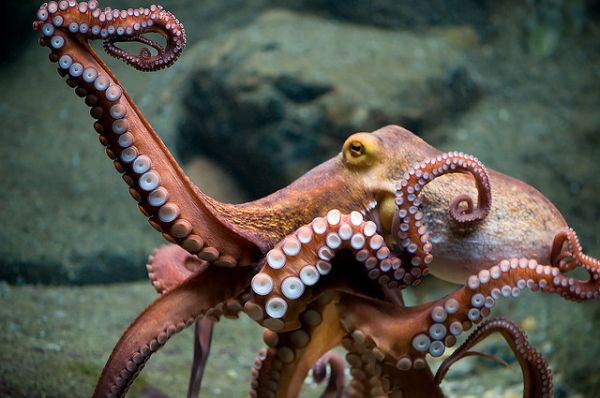
Since then, Hanlon has spent more than 30 years tracking and filming thousands of octopuses, squid, and cuttlefish—collectively known as cephalopods—as they change the pattern, color, and even texture of their skin in waters around the globe. A senior researcher at the Marine Biological Laboratory in Woods Hole, Mass., Hanlon knows cephalopods’ tricks better than anyone else in the world. And now, he’s on the cusp of unlocking the secret of their chameleon-like talents.
The New Chameleons
As disappearing acts go, cephalopods are unparalleled. Instead of settling for one mode of camouflage, they’ve mastered just about all of them. This is in part because they live in the planet’s most visually diverse environments—coral reefs and kelp forests—where patterns of light and color vary more than even in tropical rainforests. But Hanlon suspects that their abilities evolved not because they have so much to hide against but because there’s so much to hide from.“Cephalopods, being soft-bodied and nutritious, occupy that point in the food web that’s right in the middle,” says Hanlon. The creatures find themselves on the menu of virtually every ocean predator: birds, fish, dolphins, and plenty of others. And each of these predators has different visual powers. Some see ultraviolet light. Others detect polarized light. Still others have flawless nighttime vision. Cephalopods effectively have to hide from the most sophisticated eyes in the world. “We’re not looking at something humdrum that works against one or two predators in one or two habitats,” says Hanlon. Instead, cephalopods are wielders of über-camouflage: an omni-disguise that’s evolved to fool every possible prying eye.
But camouflage for a cephalopod is about more than just a color scheme—the creatures can change shape too. Cuttlefish splay and ruche their arms, protruding small studs from their skin, until they resemble floating algae. Some octopuses transform themselves into rolling rocks or coconuts by walking on two arms while wrapping the others around themselves. And the most talented charlatan of them all, the mimic octopus, seems to imitate an entire toxic menagerie. Pulling its arms back into a flat leaf, it suddenly resembles a flounder. By hiding six arms and its head in a burrow, it passes for a sea snake.
Yet for Hanlon, the work is gratifying. He knows cephalopods could be the key to understanding camouflage in all species. And the creatures themselves still dazzle him. “They’re charismatic, interesting, and colorful, and they do things we don’t expect. That’s fun science.”
Finding a Pattern
And for all the astonishingly varied backgrounds that cephalopods can mimic, Hanlon believes that their disguises come in just a few basic types. In 1998, he accumulated hundreds of cuttlefish photos and started sorting them into piles based on pattern. “Much to my surprise, I came up with just a few piles,” he says. More than a decade, thousands of photos, and several quantitative measurements later, “the same three pattern templates hold,” he says. In uniform mode, the animal’s entire body takes on the same uniform brightness, like a sandy floor. In mottled mode, the body displays small repetitive patches of light and dark, like a gravel bed. And in disruptive mode, it has bigger patches that sharply contrast with each other, presented in different scales, shapes, and orientations. This variation helps to break up the animal’s recognizable outline. Of course, there are plenty of minor differences, but it’s the low total number of patterns that intrigues him. “I don’t care if it’s two or 10, but I’m sure it’s not 55 or 1,000. That’s already a counterintuitive notion.”
But perhaps the strangest thing about their ability is that, while cephalopods can mimic the entire spectrum of colors, they themselves are color-blind. In 2008, Hanlon, along with fellow researchers Lydia Mathger and Steven Roberts, found a big clue: light-sensitive pigments called opsins dotted all over the creatures’ skin. Opsins are typically found in eyes and are essential for vision. The discovery raises the tantalizing possibility that these animals could sense light in a novel way. “Maybe there’s sensing going on in the skin, independently of the central nervous system,” says Hanlon.
The potential applications are as diverse as they are exciting. “Think about townships with water towers or industrial plants with chemicals in holding tanks,” says Hanlon. “When they heat up or become too cold, they become a problem.” A light-sensitive coating that could change color to control how much heat it absorbs would solve that problem. Our favorite gizmos could benefit too. A squid’s skin is just as vibrant and dynamic as an iPhone but runs on far less energy. “If we work out how biological systems handle light and add that to our technology,” says Hanlon, “the efficiency’s going to go right up.”

No comments:
Post a Comment